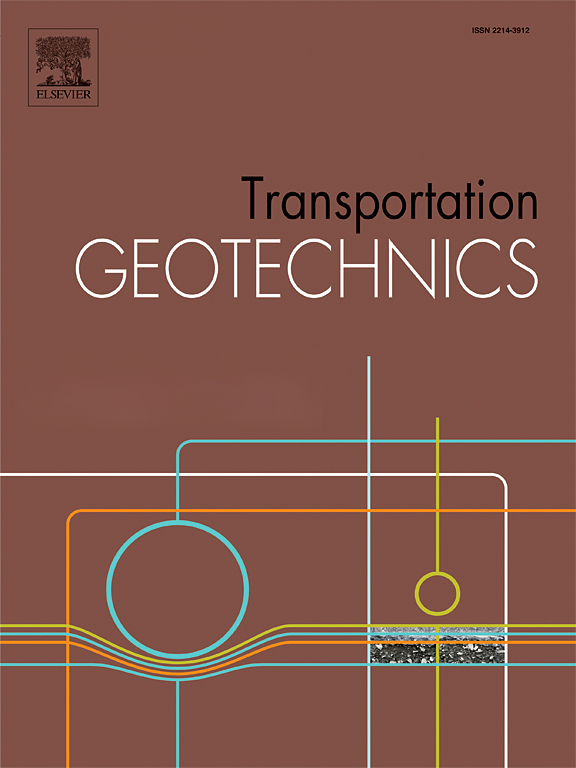Research and prediction of early-age loads in double-block ballastless track structure
IF 4.9
2区 工程技术
Q1 ENGINEERING, CIVIL
引用次数: 0
Abstract
Considering the hydration reaction of cement, a finite element model(FEM) of the coupling of temperature and humidity field and chemical field in the early age of the double-block ballastless track structure was established, and a field monitoring test on the early age of track slab was carried out with the newly constructed Fuzhou-Xiamen high-speed railway line as a case to verify the correctness of the FEM. Based on the official meteorological data from China Meteorological Administration (CMA) and the FEM, the dataset of vertical temperature and humidity gradients in the early age of the track slab was constructed, and five machine learning training models, namely, machine learning (MLR), multivariate polynomial regression (MPR), support vector regression (SVR), random forest (RF), and gradient boosted regression (GBR), were adopted to train the temperature gradient model and humidity gradient model for the early age of the track slab. The research results show that: (1) under the combined effect of solar radiation, convective heat transfer, radiative heat exchange and the cement hydration reaction, the temperature loading leads to the susceptibility of the sleepers to diagonal cracking; the humidity loading leads to transverse cracking in the center region of the surface of the track slab; (2) the finite element model with a higher accuracy provided the training dataset for the machine learning model. According to the Spearman correlation coefficient, the input features of the temperature gradient model and the humidity gradient model are determined, respectively; (3) Five ML methods were used to train the temperature gradient model and humidity gradient model, both of which demonstrated good generalization ability with a coefficient of determination(R2) greater than 0.85. Among these methods, GBR and SVR exhibited the best performance; From the perspective of MAPE value, the prediction effect of the temperature gradient training model was better than that of the humidity gradient training model; (4) The curing method and the average value of the relative humidity were the important input features influencing the training models for the temperature and humidity gradient loads, respectively. This finding provided an important guideline for the construction of ballastless track structures.
双块式无砟轨道结构早期荷载的研究与预测
考虑水泥水化反应,建立了双块式无砟轨道结构早期龄期温湿度场与化学场耦合的有限元模型,并以新建福州至厦门高速铁路为例,对轨道板早期龄期进行了现场监测试验,验证了有限元模型的正确性。基于中国气象局(CMA)的官方气象数据和 FEM,构建了轨道板早期龄期垂直温湿度梯度数据集,并建立了五种机器学习训练模型,即采用机器学习(MLR)、多元多项式回归(MPR)、支持向量回归(SVR)、随机森林(RF)和梯度提升回归(GBR)五种机器学习训练模型训练轨道板早期温度梯度模型和湿度梯度模型。研究结果表明(1)在太阳辐射、对流换热、辐射换热和水泥水化反应的共同作用下,温度荷载导致轨枕易产生斜向裂缝,湿度荷载导致轨道板表面中心区域产生横向裂缝;(2)精度较高的有限元模型为机器学习模型提供了训练数据集。根据斯皮尔曼相关系数,分别确定了温度梯度模型和湿度梯度模型的输入特征;(3)使用五种 ML 方法训练温度梯度模型和湿度梯度模型,这两种方法都表现出良好的泛化能力,判定系数(R2)均大于 0.85。从 MAPE 值来看,温度梯度训练模型的预测效果优于湿度梯度训练模型;(4)固化方式和相对湿度平均值分别是影响温度梯度和湿度梯度载荷训练模型的重要输入特征。这一发现为无砟轨道结构的建造提供了重要指导。
本文章由计算机程序翻译,如有差异,请以英文原文为准。
求助全文
约1分钟内获得全文
求助全文
来源期刊

Transportation Geotechnics
Social Sciences-Transportation
CiteScore
8.10
自引率
11.30%
发文量
194
审稿时长
51 days
期刊介绍:
Transportation Geotechnics is a journal dedicated to publishing high-quality, theoretical, and applied papers that cover all facets of geotechnics for transportation infrastructure such as roads, highways, railways, underground railways, airfields, and waterways. The journal places a special emphasis on case studies that present original work relevant to the sustainable construction of transportation infrastructure. The scope of topics it addresses includes the geotechnical properties of geomaterials for sustainable and rational design and construction, the behavior of compacted and stabilized geomaterials, the use of geosynthetics and reinforcement in constructed layers and interlayers, ground improvement and slope stability for transportation infrastructures, compaction technology and management, maintenance technology, the impact of climate, embankments for highways and high-speed trains, transition zones, dredging, underwater geotechnics for infrastructure purposes, and the modeling of multi-layered structures and supporting ground under dynamic and repeated loads.
 求助内容:
求助内容: 应助结果提醒方式:
应助结果提醒方式:


